|
2015 Airshows
Titusville (Tico), FL
Virginia Beach, VA
Seymour Johnson AFB, NC
Halls, TN
Warsaw, IN
B-29 Air Power Tour Fort Wayne, IN
Thunder over Michigan, Bellevue MI
Warbirds over the Beach
Warbird
Photo Review
Warbirds at Military Aviation Museum
Airshow 2015, Virginia Beach, VA - May 15-17 - Photos taken Friday and
Saturday, May 15-16, 2015.
Up close and personal is the best way to
describe the Warbirds over the Beach Airshow produced each May by the
Military Aviation Museum. This is particularly true when it comes
to the take-offs and landings, due to the layout of the airport.
The main grass runway is oriented east-west (Runways 11-29) and is
squeezed in between the museum hangars on the north side and a grove of
trees that mark the property line to the south. The crowd line
aligns with the south side of the hangars, making for one of the best if
not the best venues I have attended for being close for take-offs and
landings. This is an all warbird show! With the exception of
several aircraft, all of the warbirds are owned and operated by the
Military Aviation Museum. No civilian aerobatics, no jet trucks or
cars; just warbirds. As it should be.
Friday: I arrived about noon time
and spent the rest of the day looking at displays in the Museum,
watching warbirds take off and land, and venturing down to the west
hangars. The contain WWI aircraft, the Mosquito, and an original WWII
German hangar purchased by the Museum and then rebuilt on the premises.
On Friday there was a stiff wind out of the
east which allowed for some great take-offs from the west.
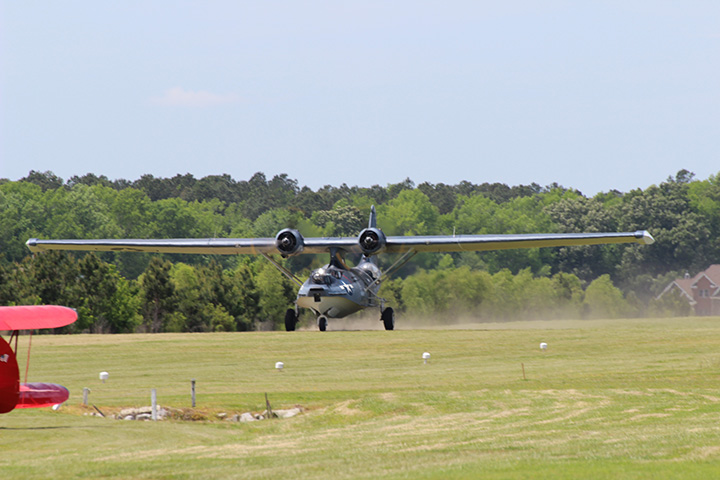
Not long after lunch the Museum's PBY took off. Starting way back
to the right of the house, in the right edge of the photo, I noted that
the trees on the south side of field act like an amphitheater and bounce
the engine sounds right back at us on the north side. Once the
warbirds went to takeoff power there was no doubt they were on the
takeoff roll, even though they were initially blocked from view.

I was set up just to the west of the Museum's hangar complex, which gave
me an excellent location to watch the warbirds on takeoff and start to
rotate.
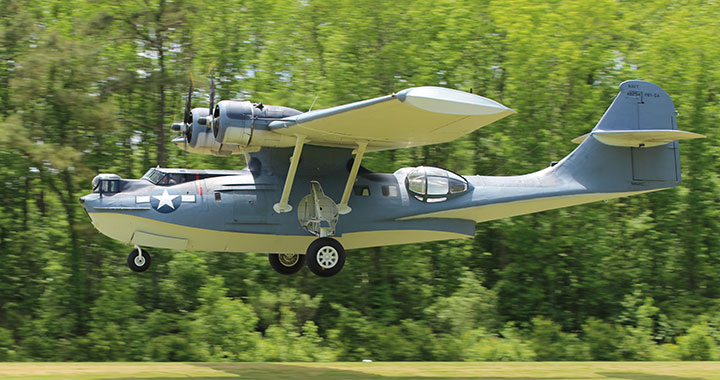
And I had an unobstructed location as they got airborne.

Heading towards the Atlantic Ocean the PBY has just flown by the
Hurricane, P-51, Wildcat, Corsair, Skyraider and P-40.

Following right behind the PBY was the Museum's Ju-52, formally operated
by the Commemorative Air Force (CAF). I think this is the first
time I have seen the aircraft since it was at the Indianapolis Airshow
several years ago. It is good to see that it is in good hands and
flying.
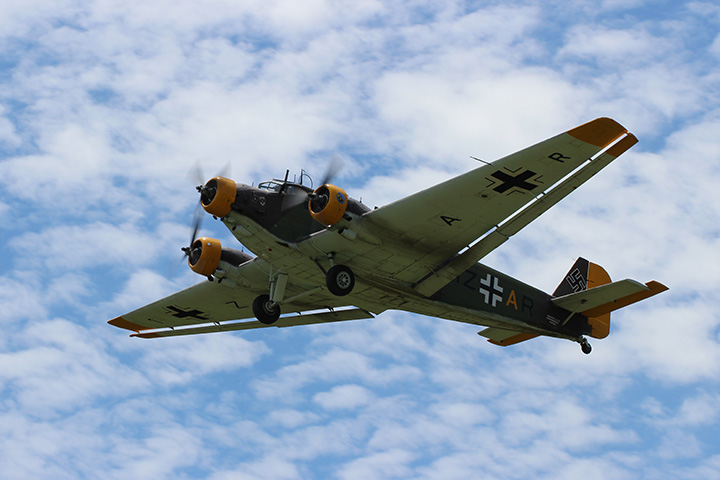
It did not nearly need the runway the PBY did to get airborne.

P-51 "Old Red Nose", the first aircraft purchased by the CAF in the
1950a that started the warbird movement, took off next with a passenger.
Here the Mustang has rotated back down the runway and is passing over
four the the seven T-6s that came in to help out with the show.
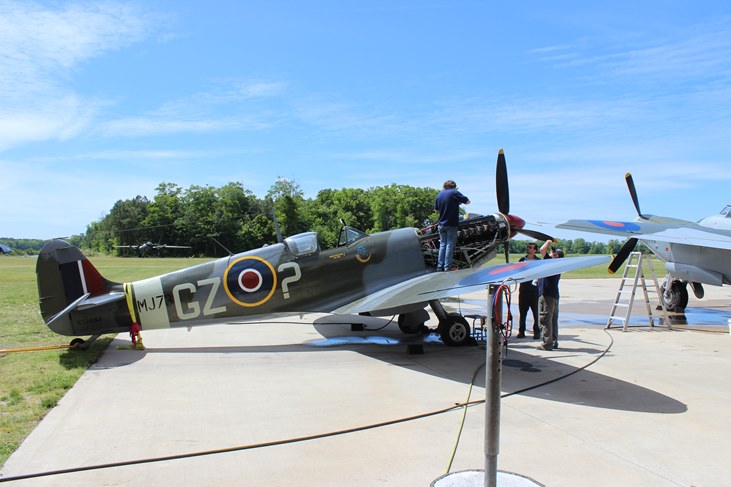
There was a lull in the flying so I wandered
down to the hangars that face west. One hangar was dedicated to
WWI replica and restored aircraft, one was the German WWII hangar, and
one was where the Spitfire was being worked on and the Mosquito was
getting washed.
The Spitfire had some sort of engine problem
that did not get repaired in time for it to fly in the show. The
cowlings were put back on the aircraft, and it was towed out to the
fighter ramp and put on static display.
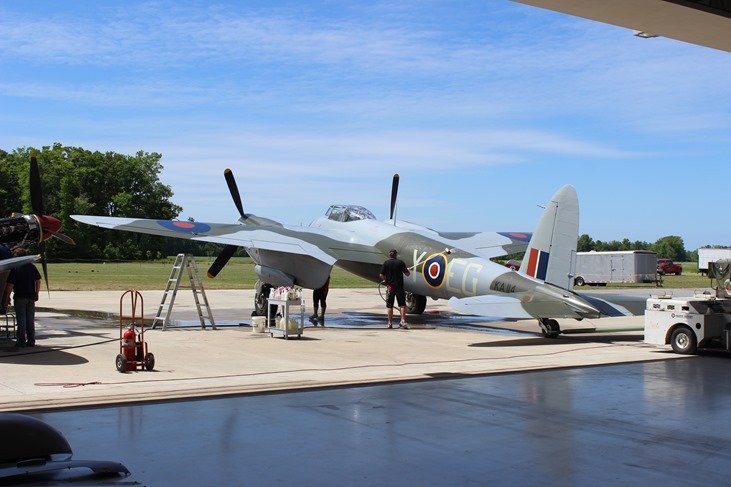
The Mosquito was getting a bath in anticipation of flying during the
weekend.
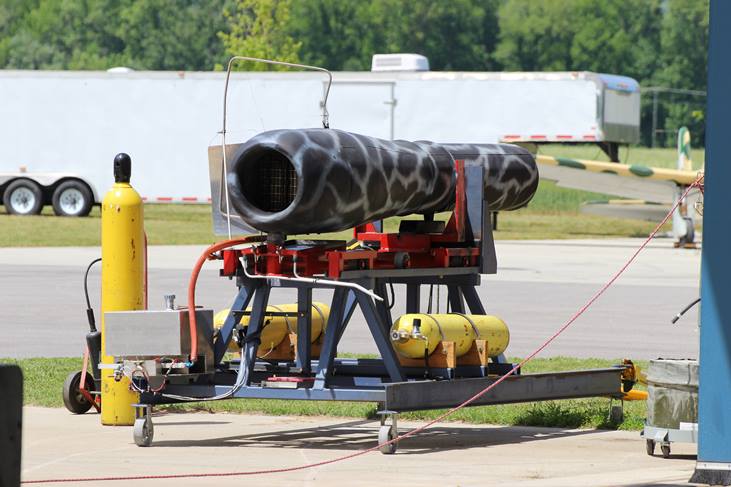
Also seen was this V-1 ramjet engine that is set up to be run. I
was hoping it would be moved out to the ramp in front of the hangar and
run. No such luck.

Later in the afternoon the Museum's
Skyraider came roaring down the grass runway on its way out.


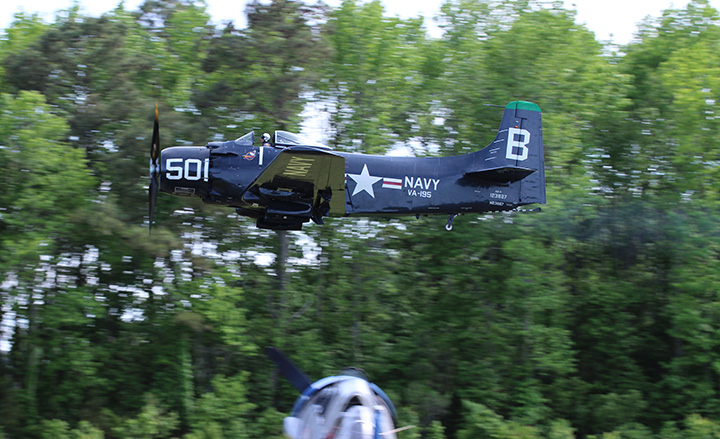


Being close to the fighter ramp allowed me to watch the fighters start.
In this case it was the Hurricane.

The CAF's SBD had just arrived and taxid in front of the Hurricane.


Saturday: Saturday was another perfect flying day and I
arrived as the gates opened. Shown below are a few highlights of
the day. There was just too many warbirds (Actually one can never
have too many warbirds!) participating to show them all in a flying
mode. All of the bombers, fighters and cargo aircraft at the show
have been included either in Friday's section, or Saturdays.
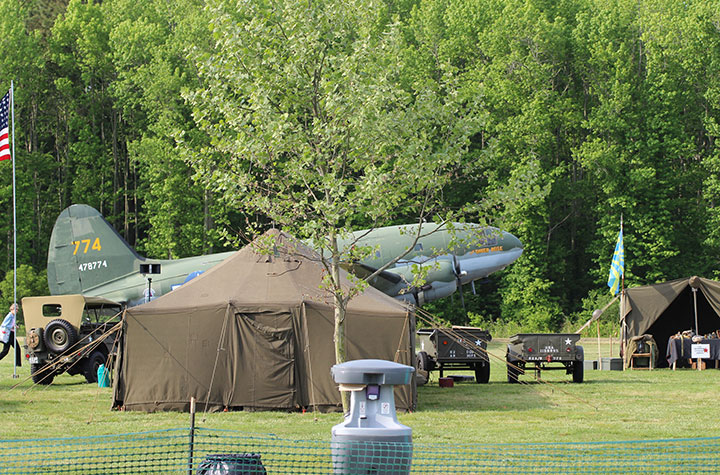
As I was driving out to the airport I could see the C-46 "Tinker Belle",
another former CAF aircraft, flying around the area after coming up from
Monroe, NC. I was able to take this shot of her on the landing
rollout from my location in the parking lot. Shown here are
several of the WWII tents and vehicles in the re-enactor display, which
is the second largest of its kind I have seen.
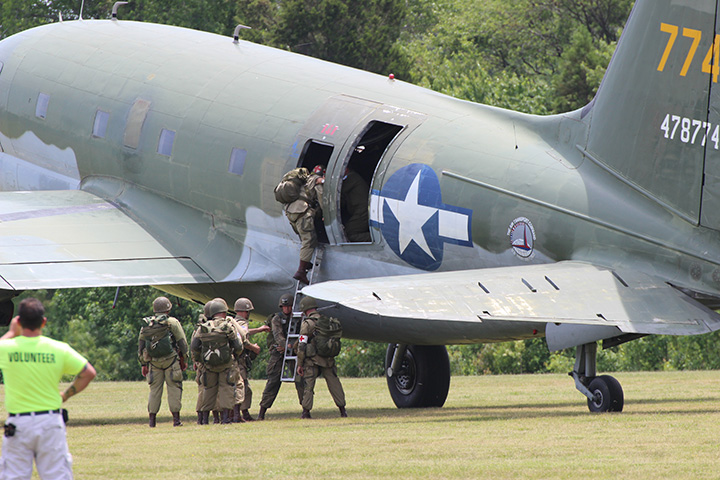
Show time! WWII re-enactor airborne troops load up into the C-46 for
a static line drop which was the first time I had seen this aircraft do
this. Note the smaller passenger doors within the larger cargo
door. It is a long way up the ladder.
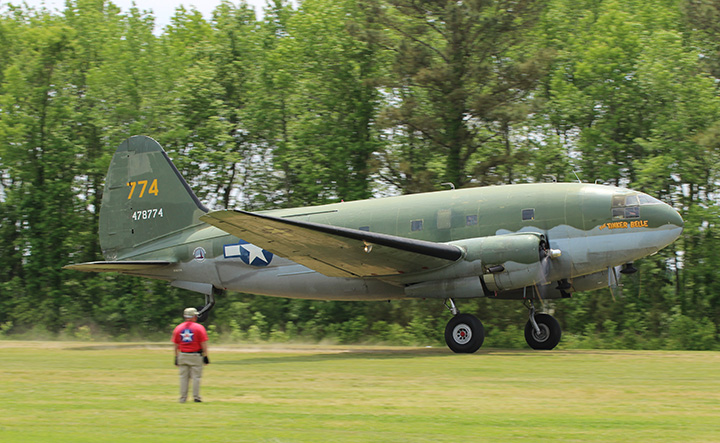
On the takeoff roll.
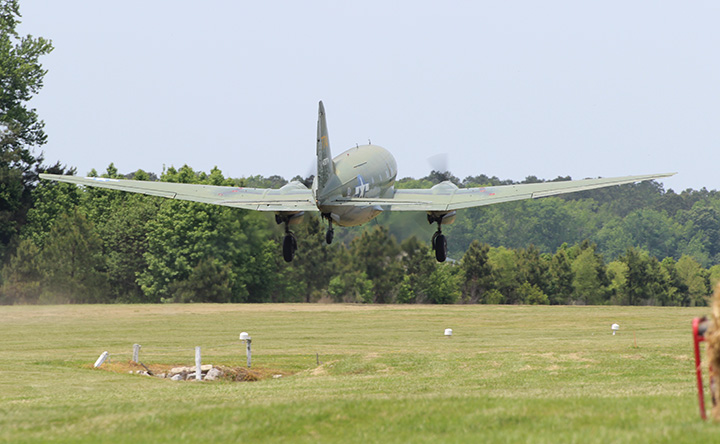


There are only three flyable Polikarpov Po-2s (U-2) flying in the US and
this one is owned by the Military Aviation Museum. This was
another first for me as this was the first time I have seen one fly.
Designed in 1928 as a trainer around 40,000 U-2s and Po-2s were built up
until 1953.

The Po-2 is the post WWII version of the aircraft, which was originally
designated the U-2, of which 33,000 were built.
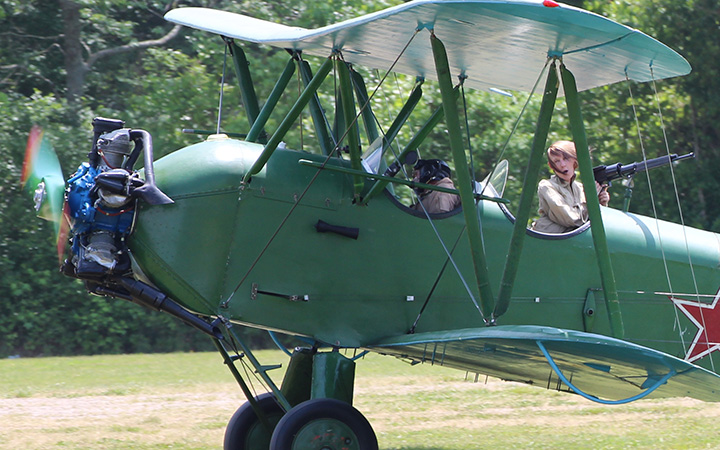
A nice touch with the female gunner in the aircraft. The Po-2/ U-2
is most well known among WWII historians as the aircraft used by the all
female Russian 588th Bomber Regiment and commonly known as the 'Night
Witches", because of their night harassment raids behind German lines on
the Eastern Front. Some of the pilots had 1,000 missions by the
time the war ended.

After the Po-2 taxied by I moved all the way down to the west end of the
field. I had become obvious that I was out of position to be able
to be close to the fly-bys that were flying a modified pattern over the
cross-wind runway. This allowed for better photos of the flying
aircraft.
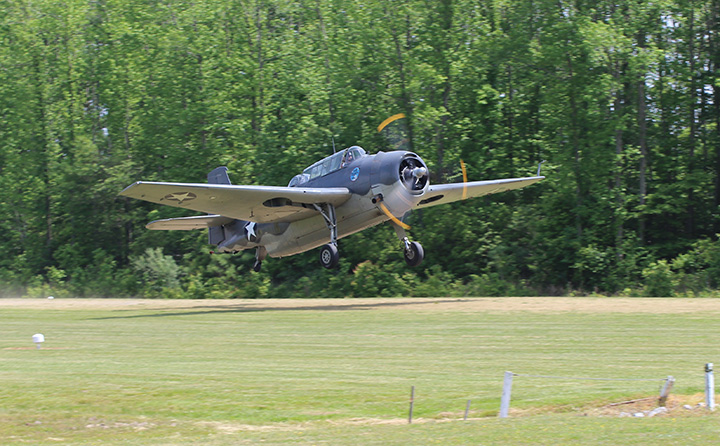
And I was in position to be able see most of the aircraft rotate on the
takeoff.


The Grumman Wildcat with the flaps down virtually jumps into the air and
was climbing fast by the time it got to my position.

There were several "loose" formation passes by
the Navy aircraft.
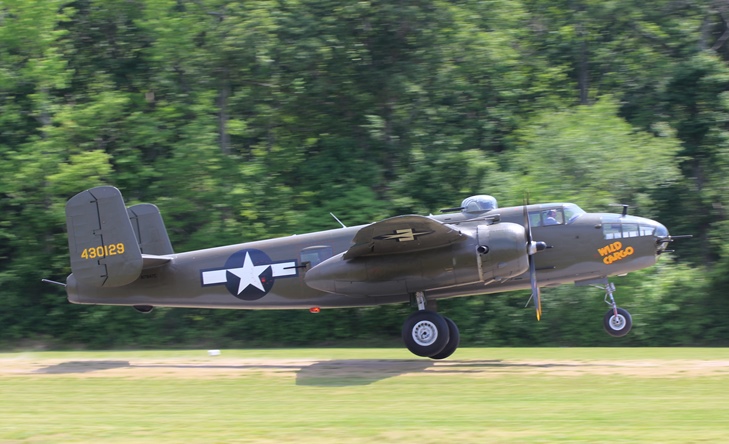
B-25 "Wild Cargo" became airborne right in front of me.

As did the P-40.



One of the more anticipated aircraft at the
show was the Me-262 seen here starting its fly-by. According to
what I was told it is not allowed by the FAA to operate on grass,
although this was what the aircraft operated from during WWII. So
it flew in from a remote base.
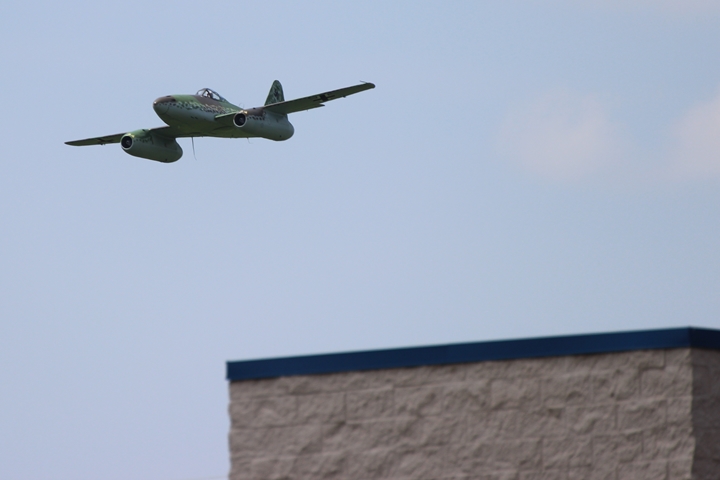
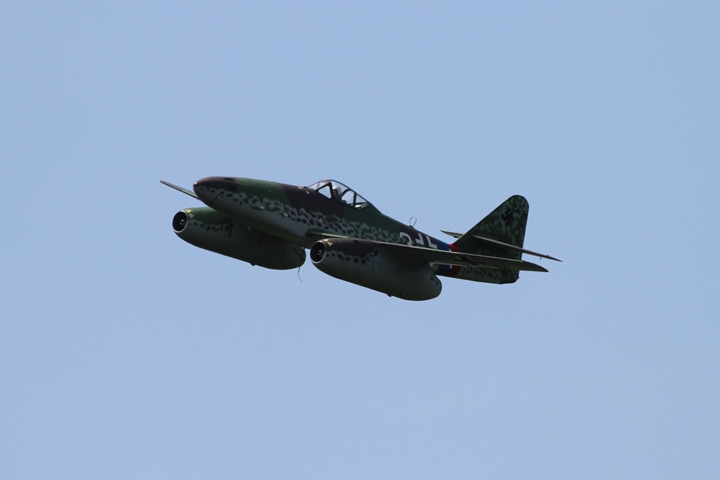


But the most anticipated aircraft of the weekend was the DeHavilland
Mosquito, seen here on the take-off roll. The weapon in the left
of the photo is the famous or infamous German 88, which was firing
blanks at many of the warbirds as they flew during the weekend.
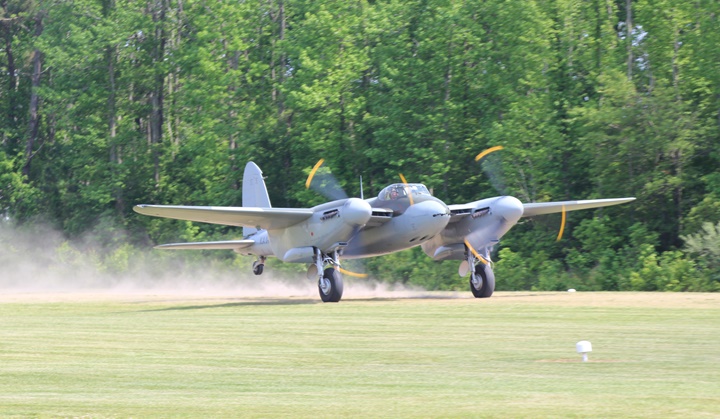
The dry grass runway and its dust helped in showing the movement of many
aircraft at the show during the weekend.
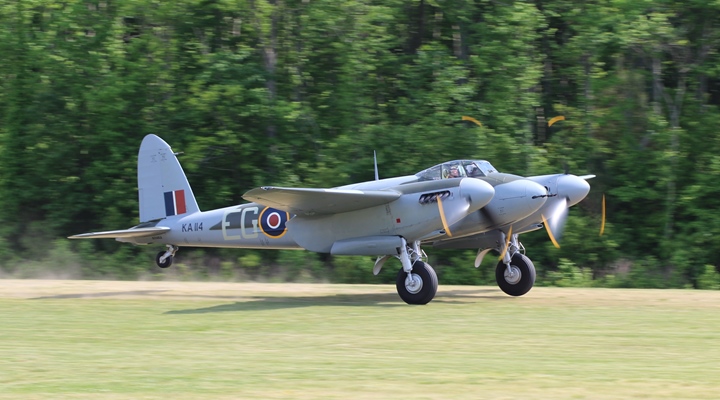

The Mosquito used up quite a bit of runway
and did not lift off until beyond me.

The Mosquito did not fly the same pattern as the rest of the warbirds
but flew in formation with the Hurricane at altitude over he crowd.
This was a disappointment as all one could see was the underside of the
aircraft. Actually the best part of the Mosquito flight had
already taken place, which was the takeoff a few minutes before.
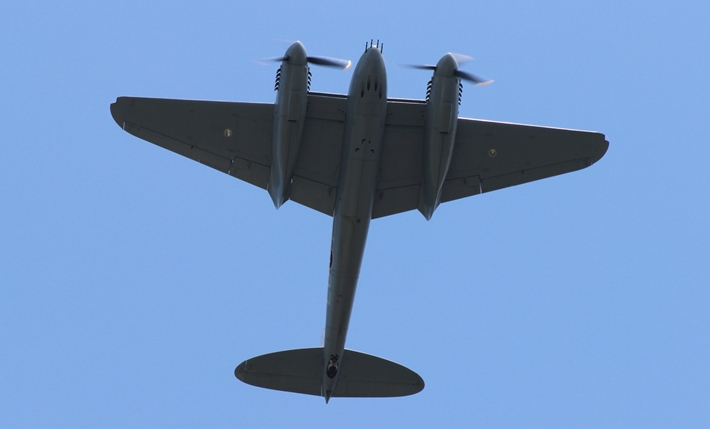
From what the narrator said, this may be an
insurance issue. He specially thanked the insurance company for
allowing the aircraft to fly and it may be that to fly the Mosquito can
not do any low airshow passes to get the insurance needed to fly the
show.
For the warbird enthusiast, Warbirds over the
Beach is well worth the trip to visit. This was my first visit
after two previous aborted trips and I do plan to return in the future.
Again the strong point of this show is the closeness of the runway and
the ability to be able to watch many of the warbirds rotate and takeoff
in front of you, if in the proper position.
Side trips
It is a long way between Indiana and Virginia Beach,
and along the way I continued my practice of making stops of places of
interest.
Marietta, OH

Marietta, OH was the location of the first
permanent settlement of Europeans in Ohio in 1788. This display,
which has us looking north, in the Campus Martius Museum in Marietta,
shows the Ohio River at the bottom and the Muskingum River flowing into
it. Two forts can be seen at the confluence of the rivers.
At far end of the display one can see some geometric figures, which were
built by an ancient culture that populated the area many years ago.

I was fascinated by this display and spent
most of my time in the museum looking and it and taking photos from all
different angles. This photo is now looking east from the
northwest corner of the display. To the right is Campus Martius, a
fort along the Muskingum River which is now the location of the Museum.
This photo also shows the Indian Earthworks as they originally looked
when the Europeans arrived. It is unknown how many Indian
Earthworks and Mounds were originally in Ohio, but it is estimated in
the thousands. Just a handful still exist today.
The structure above is assumed to be some sort
of ceremonial mound complex with the two long parallel walls going down
to the banks of the Muskingum River. Today if we were to build
something like this we would use laser surveying equipment, backhoes,
bulldozers and dump trucks. The ancients are to have presumed have
moved the earth in small bags carried on the backs of laborers.
Not a trivial task.

One mound that does still exists in Marietta
is the Great Mound or Conus Mound located in the original cemetery in
the area. This mound is considered to have been built by the
Hopewell culture while the Earthworks also show signs of the Adena
culture.
Parkersburg, WV

This is the former location of Fort Boreman,
a Union Civil War fort that was constructed on a bluff overlooking the
Ohio River. The fort was built to deny Confederate ships from
coming up the river, which never happened. Today it is a very nice
park that overlooks Parkersburg, WV and one can spend an hour or so
walking the area, reading the placards that have been set up to learn
more about this little know Civil War fort.
Newport News, VA

This 240mm T1 gun is the only one of its
type built and can be seen at the Virginia War Museum. Work on
this cannon was started by the Watervleit Arsenal, NY in 1950 and lead
to the development of a later 280mm version which then became the
Atomic Cannon. This is one of many displays, inside and outside of
the museum, that go all the way back to the Revolutionary War.
Titusville (Tico), FL
Virginia Beach, VA
Seymour Johnson AFB, NC
Halls, TN
Warsaw, IN
B-29 Air Power Tour Fort Wayne, IN
Thunder over Michigan, Bellevue MI
|


















































